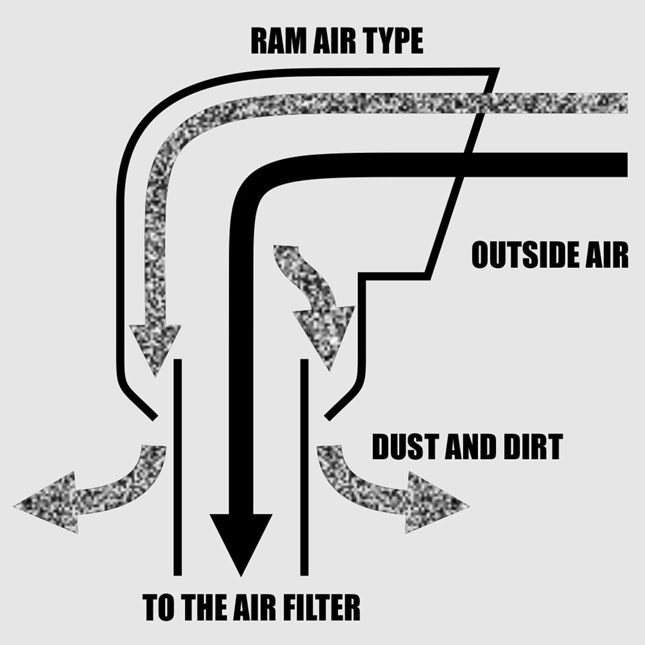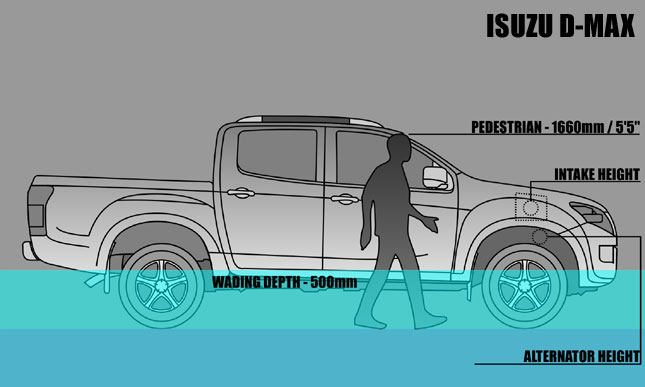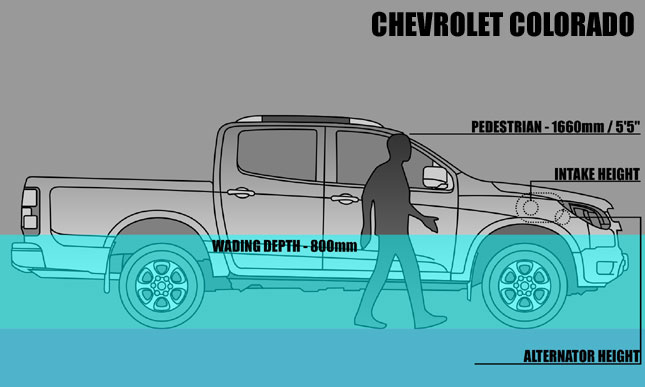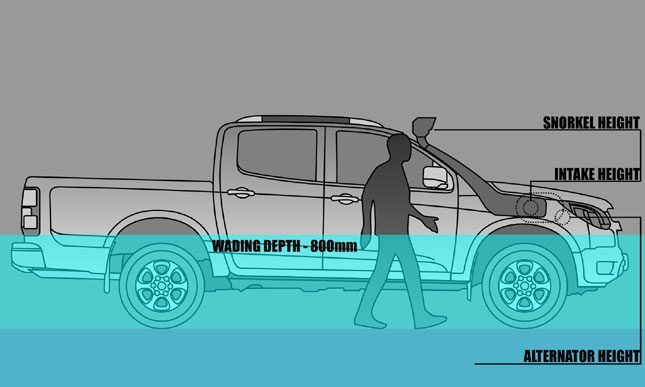Installing a snorkel on their vehicle. When setting up a “rig,” one of the most powerful weapons in an off-roader’s arsenal is the snorkel (aka raised air intake). This simple device does exactly what it says on the box. It acts as a snorkel, allowing your engine to breathe underwater. But novice off-roaders and perhaps vehicle owners who simply want the extra security of a snorkel need to keep a few things in mind when buying and installing this nifty accessory.

1. Find out your vehicle’s rated wading depth, and determine why it’s rated that way. Water entering the air intake is not the only danger to your vehicle. A vehicle’s rated wading depth takes into account electrical, mechanical and electronic components that might be damaged in a water crossing, as well as how well sealed the cabin is from water intrusion. For example, the Chevrolet Colorado and the Isuzu D-Max have identical intake heights, but different rated wading depths. The former’s wading depth is 800mm, while the latter’s is 500mm.
Note that despite the high intake placement and relatively high alternator mounting, the D-Max is not rated to wade in water that comes up over its doors. While it will most likely survive wading through higher floods with a snorkel, better door seals and waterproofing might be a good idea if you want to do this regularly.
For vehicles with no rated wading depth, there is a distinct possibility that exposed fluid reservoirs, electronics and electrical in the engine bay are not hardened against water intrusion. Thus, even if you do fit a snorkel to these types of vehicles, there is no guarantee that they will not experience mechanical or electronic damage during water crossings.



2. Find out if there are systems available for your vehicle. The easiest way to ensure a perfect snorkel fit is to buy one made specifically for your vehicle. While it is possible to customize a snorkel for vehicles where no ready-made one is available, it is an involved and costly process, and you may need to change your internal air-intake assembly to make one fit. Most commercially available snorkels are specifically designed to fit snugly against the bodywork. These ship with gaskets and seals to prevent leaks. They’re also sized to bolt onto the bodywork where your standard air intake sits.
3. Don’t skimp on quality. Cheap unbranded snorkels may look the same as the real thing, but sub-par plastic quality means less resistance to UV damage and small impacts. Original snorkels are made with thicker, tougher plastic to withstand the rigors of off-roading. Original snorkels are also “tuned” for the breathing requirements and capacity of the engine. A wrong or generic snorkel can choke the engine at higher rpms. The hoses and the gaskets that come with cheap kits may also not be up to the task of surviving actual inundation in a flood.
4. Decide what kind of system you want. There are generally two types of heads for commercial snorkel systems. The most common type is the ram type. This uses a forward facing duct into which air is “rammed” when the car is moving at speed. This high-speed airflow pushes any dirt and water to the back of the snorkel head, where it drains out through holes in the head or through a water dump valve before the air filter.
The other type is the cyclone or vortex type. In this one, tilted vanes inside the bowl-shaped head cause the air to swirl around inside. This swirling motion causes centrifugal force to push dust, dirt and water out to the sides of the bowl, where they’re collected at the edges of the bowl. This is more effective in keeping your air filter clean, although it doesn’t flow as well as the ram-type, which may affect power and fuel economy. As ever, your mileage may vary.
5. Install it properly. Make sure you have all the tools and materials you need before starting the installation. If you can’t do it yourself, there’s no shame in asking for help!
6. Be prepared to cut holes in your bodywork. To work properly, the snorkel needs to be bolted to the body, and the air tube has to pass through the fender. If you do not have the equipment, it’s best to take your vehicle to a shop that specializes in snorkel installation. Make sure that the workers doing the job will properly rust-proof the edges of the cut; otherwise, you may face corrosion issues in the future.
7. Silicone sealant is important. A snorkel will not work properly if it is not properly sealed. Make sure you get a good bead of sealant around all joints and gaskets, where required.
8. After use, check for water ingestion and leaks. After every crossing in which your engine bay is inundated, check to make sure the snorkel is doing its job. Detecting leaks, cracks or loose connections early can save you costly repairs.
9. Remember that snorkels are not magic. A snorkel will not prevent electronic components from shorting out, or differentials and gearboxes from ingesting water and experiencing problems. More important, it will not prevent fast-moving floodwater from carrying your vehicle away, or standing water from seeping into the cabin if you get stuck. Walking out the route beforehand or watching other vehicles wade through first will help give you an idea of whether it is safe to proceed or not. Above all, while wading through the water, a vehicle needs the proper gearing and torque to push the mass of water in front of its bumper, just like a bulldozer. A vehicle without the low gearing of a low transfer case is not designed to push the water above its original rated wading depth.
10. Even with a snorkel, keep the wading to a minimum. While the manufacturer tells you the wading depth, the untold secret is the ideal distance that the vehicle can traverse while partially submerged in water. A few car-lengths of wading should be fine, but not a few kilometers–even with a snorkel. The ability to breathe submerged and endurance swimming are not exactly the same thing. In the end, while snorkels do help prevent costly engine damage when crossing water hazards or floods, this simple adage still applies: When in doubt, don’t.
Illustrations by Niky Tamayo
Article by TopGear